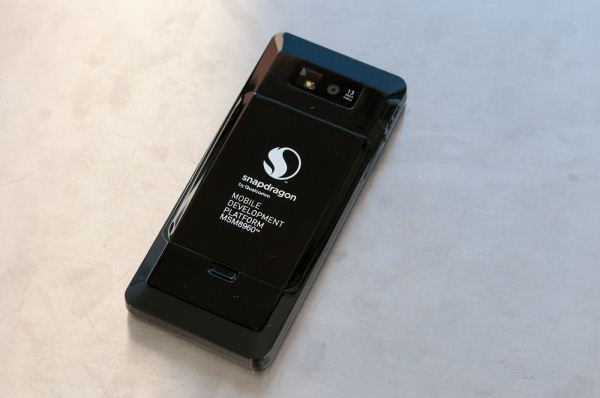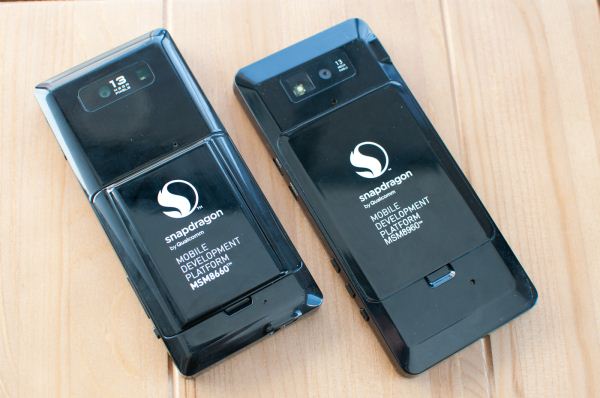Qualcomm Snapdragon S4 (Krait) Performance Preview - 1.5 GHz MSM8960 MDP and Adreno 225 Benchmarks
by Brian Klug & Anand Lal Shimpi on February 21, 2012 3:01 AM EST- Posted in
- Smartphones
- Snapdragon
- Qualcomm
- Adreno
- Krait
- Mobile
If you've been following our SoC and smartphone related coverage over the past couple of years, you'll probably remember how Qualcomm let us take home an MDP8660 from MWC 2011 and thoroughly benchmark it. Qualcomm has done essentially the same thing this year, this time sending their latest and greatest MSM8960 SoC inside the aptly named MSM8960 Mobile Development Platform (MDP) just before MWC 2012. The timing is impeccable as we're fully expecting to start seeing MSM8960 based phones next week at MWC, and we've been telling you to hold off on any smartphone purchases until the 8960's arrival. Today we're finally able to give you an indication of just how fast Qualcomm's next-generation Snapdragon S4 will be.
We've already been teased MSM8960 and Krait a few times, and have talked about the architecture and what to expect from the SoC itself. The super short recap is this: Krait is the name of Qualcomm's new out of order ARMv7-A compatible CPU architecture (previous generations of Snapdragon used Scorpion) which is designed for TSMC's 28nm process. Inside MSM8960 are two Krait cores running at up to 1.5 GHz, Adreno 225 graphics, improved ISP and Qualcomm's new baseband with support for nearly every air interface out there.
The MDP we were sampled is clearly a descendant of the MDP MSM8660 we were given last year, sharing the same black utilitarian look and purpose-built design, though it's notable that the new device is markedly thinner. MDP MSM8960 is running Android 4.0.3 at 1.5 GHz, and includes 1 GB of LPDDR2, and a 4" 1024x600 display. It's an interesting note to make that both Intel and Qualcomm have somehow settled on 1024x600 for their reference designs.
We also asked Qualcomm for a copy of the old MDP8660 for comparison purposes, just to see how far we've come since the first dual core Snapdragon SoC.
| Qualcomm Mobile Development Platform (MDPs) | ||
| MDP MSM8660 | MDP MSM8960 | |
| SoC | 1.5 GHz 45nm MSM8660 | 1.5 GHz 28nm MSM8960 |
| CPU | Dual Core Scorpion | Dual Core Krait |
| GPU | Adreno 220 | Adreno 225 |
| RAM | 1 GB LPDDR2 | 1 GB LPDDR2 |
| NAND | 8 GB integrated, microSD slot | 16 GB integrated, microSD slot |
| Cameras | 13 MP Rear Facing with Autofocus and LED Flash, Front Facing (? MP) | 13 MP Rear Facing with Autofocus and LED Flash, Front Facing (? MP) |
| Display | 3.8" WVGA LCD-TFT | 4.03" SWVGA (1024x600) LCD-TFT |
| Battery | 3.3 Whr removable | 5.6 Whr removable |
| OS | Android 2.3.2 (Gingerbread) | Android 4.0.3 (ICS) |
We're taking a look at just CPU, GPU, and power performance today on MSM8960, as cellular baseband is disabled on the MDP just like it was when we looked at the previous MSM8660 MDP. We'll get a chance to investigate that further in the future, again right now the key areas are CPU, GPU, and power.
As we talked about in the previous MDP piece, the purpose of the MDP is just to serve as a reference design for both Qualcomm to get its Android port running on, and also for individual developers to profile and test their applications against. It's analogous to TI's OMAP Blaze platforms - you won't ever likely see one out in the wild, but it's a reference target that the silicon vendor leverages to port Android, and a piece of hardware that OEMs can use as a reference when they start customizing and building handsets.
Just like last time the MDP also comes with a software build that lets us easily enable or disable vsync on the device, restart surfaceflinger, and then run benchmark tests. There's no such analog for shipping retail devices, only development builds contain this functionality. As there are parts of each benchmark that could instantaneously peak over vsync's 60 FPS on some of the shipping platforms we're comparing to, we're providing results with vsync on and off.
In addition, last time when we ran tests on the MDP MSM8660 I noted that the governor was set to "performance" mode, which means it doesn't adaptively change CPU frequency as a function of load - it was 1.5 GHz all the time. This time the MDP MSM8960 came running with the much more typical "ondemand" governor selected, which does scale CPU frequency as a function of load, so there's less of a concern about the lack of pauses while the CPU changes performance states making results non comparable.


















86 Comments
View All Comments
k1ng617 - Tuesday, February 21, 2012 - link
Honestly, I don't trust Linpack and believe it is probably one of the most outdated android benchmarks, that doesn't represent what a person will see with realworld user experience.Can you try out Antutu & CFBench and post the scores please?
juicytuna - Tuesday, February 21, 2012 - link
Indeed. Linpack is a test of software as much as hardware, who knows what kind of optimizations they could have done to the VM to get these headline grabbing scores.GPU is distincly meh for a 2012 soc, and single threaded performance doesn't seem that impressive to me. Sunspider and Browsermark seem to be on a par with what you'd expect to see from an A9@1.5ghz.
And how much of that 'faster feel' can be attributed to NAND performance?
metafor - Wednesday, February 22, 2012 - link
There are some hickups in Android that have to do with the UI thread looking up storage but for the most part, it's a CPU thing. The thing to keep in mind is that UI fluidity is an entirely different type of code than Javascript parsing. And looking at the Basemark results, Krait is quite capable in that department.arm.svenska - Tuesday, February 21, 2012 - link
Why is the phone so long? I get that it is a reference design. But, could someone tell why it is like that?douglaswilliams - Tuesday, February 21, 2012 - link
I don't know for sure, not a definitive answer here, just adding to the discussion.Like you said, it's a reference design (Mobile Development Platform). They put as little time as possible into making this pretty.
When I was in college we had some old development platforms for some Motorola chips that were essentially a large circuit card with ports on all the sides for all the I/O and buttons to push for different operating modes like programming mode. It in no way looked like what an actual product would look like - because that wasn't its purpose.
peevee - Tuesday, February 21, 2012 - link
Out-of-order Krait core at 1.5GHz consumes only 750mW. An Atom core at the same frequency consumes as much as 10x of that! While being in-order, no faster, if not slower! What a fail for Intel!Khato - Tuesday, February 21, 2012 - link
You might consider reading Anandtech's article covering the Intel Atom Z2460 launch in January - http://www.anandtech.com/show/5365/intels-medfield...Granted, we're only given SunSpider and BrowserMark benchmarks for the Atom Z2460 reference platform, but they're both actually ahead of the numbers for the Krait MDP - 1331.5 versus 1532 on SunSpider and 116425 vs 110345 on BrowserMark. While I expected Atom to be competitive, I'd thought it likely for Krait to be slightly ahead on the single threaded benchmarks, so I'm somewhat surprised that it's not. (Note that I'm somewhat surprised that there was no mention of how Krait compares to Atom Z2460 in the article.)
As for power, that same article states that the Atom Z2460 SoC consumes ~750 mW at 1.6GHz - that's for the entire SoC, not just the CPU core. It'll be quite interesting to see how actual battery life compares between products once released.
metafor - Tuesday, February 21, 2012 - link
The difference is, one is Intel's numbers and the other is a 3rd party reviewer's on an actual device.So yes, I agree. We'll have to see what actual phones using Atom will be like. Note that Sunspider isn't the end-all of "single-threaded performance" either. The JIT for Javascript on x86 is far more mature -- having been developed for a decade now -- than it is for ARM.
Khato - Tuesday, February 21, 2012 - link
Well, I tend to trust Intel's numbers when they're actual hard numbers rather than percentages or normalized figures - they can't exactly get away with making up figures.And no question about the fact that SunSpider/Browsermark aren't indicative of all too much... but I wouldn't claim that Intel's advantages on those benchmarks are due to a superior JIT/software advantage. Remember the performance figures from that Oak Trail Tablet prototype running an early Android port from June of 2011? That was a prime example of the sort of software disadvantage that Intel had to overcome in order to get Android running well on x86. While a bit dated, here's an excellent example of the performance differences on x86 java implementations between OS (note that linux had a slightly newer version, but they were both using the latest available) - http://www.phoronix.com/scan.php?page=article&...
metafor - Tuesday, February 21, 2012 - link
No, but you'd be surprised how much a bit of pick-and-choose can help. Most comprehensive reviews are pretty rigorous with how many times they repeat a test, how much warm-up they give a device and whether or not they pick the median, average, etc.One could easily pick the best number, which can vary quite a bit especially for a JIT benchmark.
I've also seen that comparison before. There was a rather thorough discussion of it and its relative lack of merits at RWT. I'd link, but it's being marked as spam :/